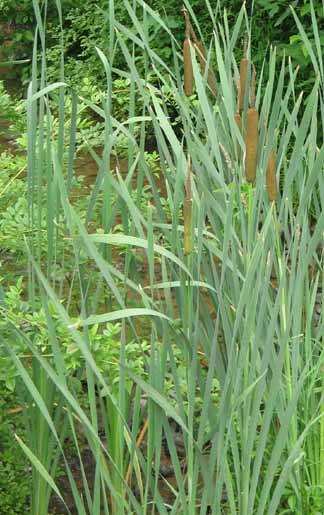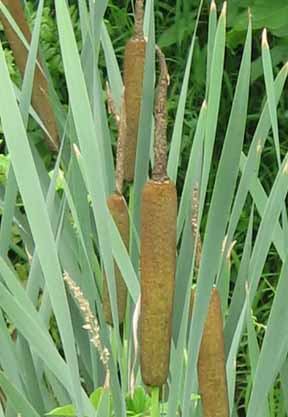Plants and People Project
Cattail - Typha latifolia L.
Grows in areas of standing water or fresh water streams throughout the US. Nicknames: bulrush,, broadleaf cattail, common cattail, reed mace.
Native Americans made a poultice out of the roots which they applied to wounds and burns. The downy fuzz from the mature female flowerheads was used to prevent chafing." Peterson Field Guides Eastern/Central Medicinal Plants
Starchy, mashed root was used as a toothpaste. NativeTech.org
The round stalks (dried green) were woven into mats to cover the exterior of a wigwam or the floor. Buoyant leaves used for twine and small toys. NativeTech.org
The fibers in the leaves of the cattail were used by many Indians to make cordage.
"One of the most ingenious uses of cattail, bulrush and the tule plant was making floating decoys to lure waterfowl to roosting areas to be bow-hunted, netted, or snared." NativeTech.org
Parts of the cattail plant have been eaten. The root was ground into a meal by Indians and early colonists. The root is mostly starch. Some people eat the early spring shoots. In fact, there are those who collect the immature flower stalks and eat them like corn on the cob. The Audubon Society Field Guide to North American Wildflowers Eastern Region
Additionally, the leaves can be woven into mats. The brown flower stalks are collected, dried and used in flower arrangements and interior decorating. Cattails - Uses by Humans and animals
"Cattails yield a beige dye color." Dyeing Wool
Cattail is suspected of being poisonous to grazing animals.
Cattail stands are important habitat for red-winged blackbirds, marsh birds, rails and muskrats. Chesapeake Bay Program
Close-up of cattail flower. It is about 6 inches in length.
Identification and other facts / More facts / PLANTS database
Common Cattail

This patch of cattail is growing along the bank
of a small
creek located in central Pennsylvania.
DISCLAIMER: These pages are presented solely as a source of INFORMATION and ENTERTAINMENT. No claims are made for the efficacy of any herb nor for any historical herbal treatment. In no way can the information provided here take the place of the standard, legal, medical practice of any country. Additionally, some of these plants are extremely toxic and should be used only by licensed professionals who have the means to process them properly into appropriate pharmaceuticals. One final note: many plants were used for a wide range of illnesses in the past. Be aware that many of the historical uses have proven to be ineffective for the problems to which they were applied.
